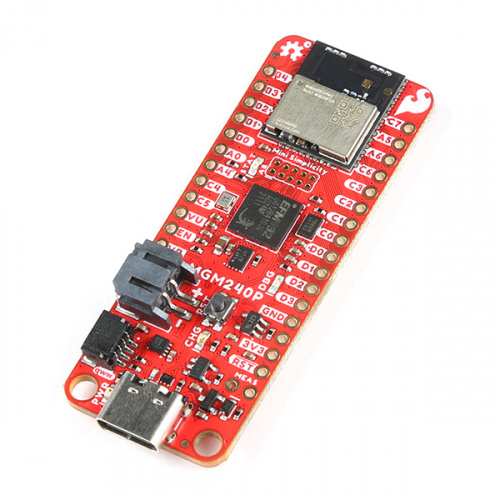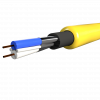×
SparkFun will be closed on Tuesday, December 24th, and Wednesday, December 25th, in observance of the Christmas holiday. Any orders qualifying for same day shipping placed after 2:00 p.m. (MST) on Monday, December 23rd, will be processed on Thursday, December 26th, when we return to regular business hours. Wishing you a safe and happy holiday from all of us at SparkFun!
Please note - we will not be available for Local Pick up orders from December 24th-December 27th. If you place an order for Local Pick-Up we will have those ready on Monday, December 30th.
At the beginning of the month, we were happy to release our newest Thing+ board, the SparkFun Thing Plus Matter - MGM240P, which introduced secure connectivity for both 802.15.4 with Mesh communication (Thread) and Bluetooth® Low Energy 5.3 protocols. The Matter protocol leverages existing IP technologies, including Wi-Fi and Thread, to build a unified wireless connectivity ecosystem for smart homes. Internet Protocol (IP)-based networking provides manufacturers with simplified development while improving device compatibility for consumers.
We wouldn't begin to assume that in the last two week's since the Thing's release, that the vast majority of users know everything this is to know about Matter. So to answer any inquiries from people who want to know more about Matter and Thread, we've decided to write up this sort of "bibliography" that we used to understand the subject. Essentially, in contrast to other wireless protocols, Matter and Thread:
- Allows for consistent operation between smart home devices and IoT platforms without an Internet connection, even from different providers.
- Communicate between major IoT ecosystems to become cross-platform devices in order to create a single wireless protocol that is easy, reliable, and secure to use.
- Have been agreed upon from multiple industry leaders like Google, Apple, Zigbee, Amazon, and more, as a single, unifying standard.
- Has been designed from the ground up to be an IoT low-power protocol that supports low latency without optimizing other applications.
- Can work as a routed mesh, so devices on a network will predominately look for the best route to every other device in the network.
- Can scale over 250 devices.
Annotated Resource List - Matter & Thread
Below, please find an annotated resource list of Matter and Thread resources - it comprises introductory information, applications, and more advanced information and presentations.
Get Started with Matter from SparkFun and Silicon Labs (video, ~54 mins) - Thinking of delving into Matter? This Talk begins with an overview of Matter - what it is, the history, the benefits, the overall ecosystem, and use cases. From there the talk reviews the Arm Cortex-M33-based MGM240P module from Silicon Labs, as well as the SparkFun Thing Plus Matter (which uses the module). The talk concludes with a smart-home demonstration of Matter in action using the board.
Here’s What the ‘Matter’ Smart Home Standard Is All About (blog) - Formerly called Project CHIP (Connected Home over IP), the open source interoperability standard known as Matter is finally here. Some of the biggest tech names have signed on, like Amazon, Apple, and Google, which means that seamless integration may finally be within reach.
Matter Specification Version 1.0 (PDF, 895 pages) - The Matter specification defines fundamental requirements to enable an interoperable application layer solution for smart home devices over the Internet Protocol. More documents can be found on the CSA's Specifications Download Request page.
Matter Protocol - IoT Device Development - Silicon Labs (website) - Matter drives the convergence between the major IoT ecosystems to create one easy, reliable, and secure wireless protocol to connect all IoT devices and networks. On this site, you will find Frequently Asked Questions, modules and SOCs, and more information on SiLabs' efforts on making this protocol as easy to access as possible.
Connectivity Standards Alliance Resources (resource hub) - The Connectivity Standards Alliance is on a mission to ignite creativity and collaboration in the Internet of Things (IoT) by developing, evolving, and promoting universal open standards that enable all objects to securely connect and interact. As a principle, they provide access to developer resources, Alliance governing documents, IPR policy, security policy, and additional support.
SiLabs Developer Documentation (resource hub) - This is probably the best resource hub for Matter and Thread available to the public to date! On this page, you will be able to find pretty much any piece of developer documentation you might need to get up and running with Matter. Develop and prototype smarter. Get to market faster.
Thread Group (website) - Thread is a low-power and low-latency wireless mesh networking protocol built using open and proven standards. Thread solves the complexities of the IoT, addressing challenges such as interoperability, range, security, energy, and reliability. Thread networks have no single point of failure and include the ability to self-heal.
OpenThread (guide) - OpenThread released by Google is an open-source implementation of the Thread networking protocol. It is OS and platform agnostic, with a narrow platform abstraction layer and a small memory footprint, making it highly portable. It supports both system-on-chip (SoC) and network co-processor (NCP) designs.
Simplicity Studio® 5 User's Guide (guide) - Simplicity Studio is the core development environment designed to support the Silicon Labs IoT portfolio of system-on-chips (SoCs) and modules. It provides access to target device-specific web and SDK resources; software and hardware configuration tools; an integrated development environment (IDE) featuring industry-standard code editors, compilers and debuggers; and advanced, value-add tools for network analysis and code-correlated energy profiling.
Unify Software Development Kit (website) - Unify SDK is a software framework that simplifies the developer experience, removing difficult parts of network control and network management as it relates to gateway and hub development in IoT applications. It can also provide Matter bridge functionality to other protocols that do not natively run matter.
Ready to Get Your Hands On Matter? Here's where to get started:
Here is the first easily accessible board of its kind that combines Matter and SparkFun’s Qwiic ecosystem for agile development and prototyping of Matter-based IoT devices.









I know a guy who is a big "fan" of IoT, even though he's not all that technical. His "day job" is as a business attorney, so he can afford a lot of "gadgets". Because he's seen a LOT of companies "fail", he maintains a rule of not buying more than one "gadget" from any one company -- I've never seen his phone, but I suspect he has a LOT of "apps" to control everything. Methinks he should be the "poster child" for Matter! ;-)